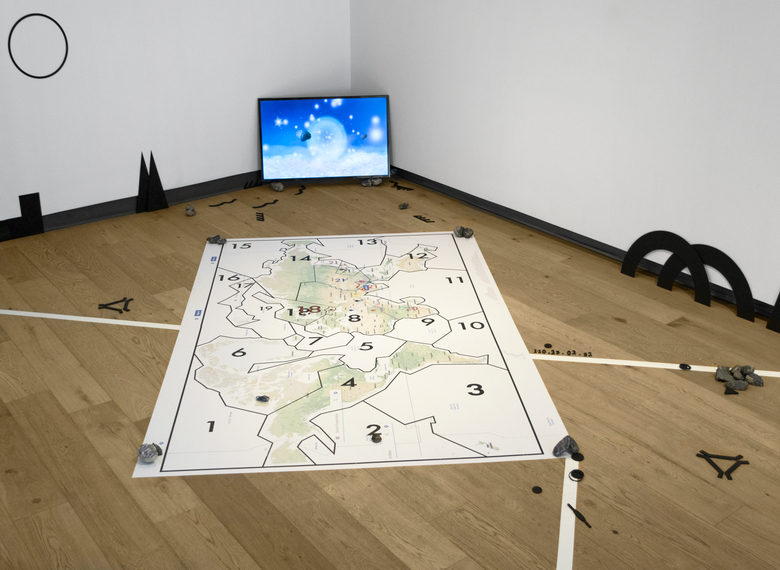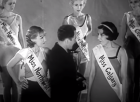As a kid growing up in Miami, I played a game on the school courtyard called “Walls.” Four players stood on the hot asphalt in boxes drawn with chalk and took turns throwing a ball, hopping from box to box, claiming each space to create an imaginary wall. I also played hopscotch on the sidewalk with my sister on weekends, creating linked boxes that snaked haphazardly through our neighbourhood, the only rule being that you had to stay in your box. These types of games feel synonymous with childhood, competing for a spot on a map made out of chalk, and marking it with your body.
Ahreum Lee’s exhibition Hopping for Hope at The New Gallery in Calgary re-imagines childhood games on a global scale, posing questions about ownership, borders, and global identity. The show re-contextualizes familiar games like hopscotch, and considers how they speak to our human desire to claim space. An emerging artist currently based in Montreal, Lee combines tactile and digital materials to create works that are welcoming, and disarming, crisscrossing the cultural boundaries they seek to explore. The show taps into a personal connection to global identity, and explores the potential confusions of the diasporic experience, of not belonging to one place. As Lee notes in the introductory text: “How do digital devices mediate our sense of space and orientation? Do my thoughts travel with me, or belong to where I am?”
Like meridians on a map, the exhibition occupies the gallery space with diagonal lines made of tape and black circles, semi-circles, and arrows. This is Lee’s take on mapping symbology. The centrepiece is a large game of hopscotch, drawn over a map of interlocking countries, including Lee’s home country, South Korea. The map is broken up into numbered areas. Piles of smooth rocks, taken from Lee’s adopted home of Montreal, surround the map. The rules of the game, based on the Korean version of hopscotch, are explained via a one channel video, featuring Lee as the game’s guide.
Behind a bright pastel background that conjures up Lisa Frank’s psychedelic designs and the 1982 film The Last Unicorn, Lee demonstrates how to hop on one foot on each numbered area. Once you reach the end, you throw a pebble behind your back with your eyes closed. According to Lee’s guide, “If the pebble lands in an unoccupied space, it’s yours!” With its simple instructions and familiar presentation, the game combines childhood nostalgia with the arbitrary outcomes of a game.
During the opening of the show, people slipped off their shoes and tried to hop the entire map on one foot, to cheers and encouragement from the crowd. It’s all about winning, after all. Only when the player paused to notice what part of the map they occupied did the deeper implications of the game become more clear. Through bodily interaction, the connection between physical space and ownership, a line or box on a map, grew more powerful and ever-present.
Lee’s examination of imaginary borders is also the focus of another video piece, situated across from the hopscotch game. In this one channel video, Lee combines screen captures of Google Street View of South and North Korea, as well as other contested geographical areas, with the flashing arrows of Dance Dance Revolution, a popular arcade game. In Dance Dance Revolution, the arrows direct players where to move their feet, but in Lee’s version, they light up at random, as if to mimic someone walking through Street View. I imagined a warped version of the video game where, rather than dancing to a pop hit with cartoon characters in the background, you moved from country to country, hop stepping over borders for extra points.
The video incorporates footage of the East Asian pseudoscience Cheok Ji Beob, which translates to “the way to make the world smaller.”1One of the principles of Cheok Ji Beob is the ability to jump through space and time. Lee plays with this principle within the unstable framing of Street View, which claims to be apolitical but in fact shifts borders based on where its accessed in the world. On the Internet, the framing of global identity on a map can be a type of game, or a skewed perception of reality. It can also be a place for wishful thinking, granting access to spaces that can only be experienced mediated through a screen.
Through bodily interaction, the connection between physical space and ownership, a line or box on a map, grew more powerful and ever present.
The final video piece connects the audio stimulation of Google Map directions, spoken by the familiar robotic female voice, to the visual rhythm of a metronome. The counting arm of the metronome is shown on two different screens, keeping time. This is juxtaposed with the audio of directions to different areas in Montreal, spoken as a series of right turns and left turns. One can imagine Lee trying to find her way in her new home, her movements offbeat and out of step.
The metronome conjures up a heartbeat, comparatively more soothing than the stilted directions of Google Maps. When placed together, the piece becomes disorienting, contrasting your internal rhythm with Google Map directions, a disembodied voice that instructs you on how to move your body in space.
In all three pieces, Lee asks viewers to consider how our sense of space is mediated by our understanding of physical maps, as well as digital tools. Throughout the show, there is a fixation on trying to organize the arbitrary act of boundaries, whether through the rules of a game or the limitations of an Internet mapping tool. Lee’s desire to analyze the disorientation of identity and space is smart in its approach. She uses tools and moves we can all recognize but in ways that allow us to understand them differently.
There is an edge to Lee’s critique of global mapping, a powerful methodology with consequences that ripple out far beyond the rules of a game. There is also thoughtful engagement with the means in which we organize space as human beings, and seek to claim it. Through her exhibition, Lee invites us to play and hop, and yes, not without hope.
Ahreum Lee’s Hopping for Hope (2019) was exhibited at The New Gallery from January 18 to February 22, 2020: http://www.thenewgallery.org/hopping-for-hope/



